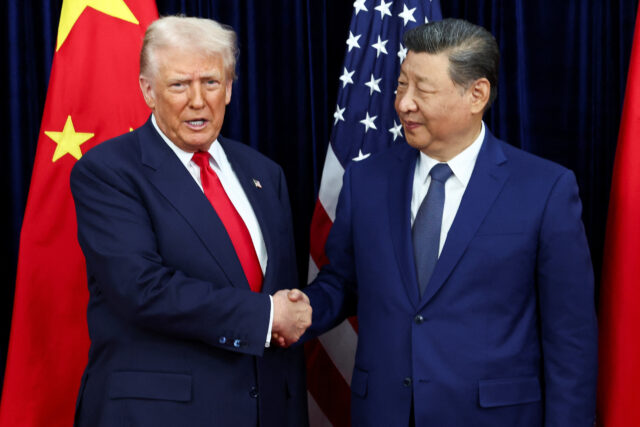
Whenever Washington attempts strategic accommodation with Beijing, the usual anxiety is felt in New Delhi. The fear cannot be dismissed: a hypothetical US-China “G2”, a condominium of the two largest global powers managing world affairs, would sideline India, dilute its strategic relevance, and reduce its diplomatic space. The recent tactical thaw in US-China relations has reignited these concerns.
Yet, the historic record of previous G2 attempts is dubious, and panic is unwarranted. The G2, as a concept, historically collapses due to incompatible worldviews, asymmetrical expectations, and Chinese overreach.
India’s approach, therefore, should not be to whine about this temporary détente. Instead, India should prepare for the post-G2 world, in which US-China rivalry escalates after the unrealistic expectations of a détente fail.
India’s strategic opportunity lies not only in managing a stable US-China balance, but in preparing for the imbalance that will follow a failed G2 attempt.
G2: An Idea That Fails
The notion of a U.S.–China G2 “condominium” i.e the two largest powers jointly managing global affairs, resurfaces every time a new U.S. president imagines cooperation will moderate Beijing. Each attempt follows the same trajectory: early optimism, Chinese assertiveness, and eventual strategic correction.
President Bill Clinton renewed MFN for China, saying: “This decision… offers us the best opportunity to lay the basis for long-term sustainable progress in human rights.”
He pushed China’s WTO entry and cast it as a “responsible stakeholder,” expecting economic integration would liberalise Beijing. Instead, China accelerated state-led industrial expansion, military modernisation, and internal repression.
President Barack Obama declared: “The relationship between the United States and China will shape the 21st century.”
His global-governance outreach, made amid U.S. financial-crisis weakness, was read in Beijing as strategic weakness. China hardened its South China Sea posture and abandoned Deng’s “bide your time” restraint. Obama’s answer was the “Pivot to Asia,” with India elevated as a core partner.
Donald Trump boasted: “He just wrote me a beautiful letter… let’s work together.”
He flirted with transactional engagement, but Beijing garnered concessions and pressed ahead with tech theft, coercive lending, and military assertiveness. Trump then swung abruptly to confrontation, reinforcing bipartisan recognition of China as a systemic rival and accelerating U.S. convergence with India.
Every G2 moment follows the same trajectory:
- Washington courts Beijing to stabilise global systems and reduce its economic and military burdens.
- Beijing interprets it as a weakness and a strategic opportunity for duplicity and coercion.
- The American establishment belatedly rediscovers Chinese revisionism.
- Confrontation resumes, harsher than before.
Why would this time differ? If anything, China has become more powerful, more revisionist, more confident, and perhaps even more brittle internally.
Threats, Opportunities For India
India may face short-term challenges as Washington temporarily shifts focus toward stabilizing its bilateral ties with China, which could soften current pressure. Beijing will likely manoeuvre to isolate India diplomatically, stall border talks, and enhance its influence in India’s neighbourhood and the Indian Ocean.
However, the fundamental structural rivalry remains unchanged. China’s ambition to dominate the Asian security order and expel the US from East Asia is firm. The American establishment views China as a revisionist challenger, making the current thaw purely tactical.
When Beijing predictably overplays its hand, in the Taiwan Strait, South China Sea, or economic arenas, US anger will return.
At that juncture, Trump is likely to face strained allies, limited traction against Russia, and a costly, unpopular foreign entanglement. The United States would then need reliable and capable partners such as India.
In this inevitable circumstance of heightened hostility and political urgency, the consequences of G2 failure will disproportionately benefit India. To capitalize, India must prepare effectively to be an indispensable partner, ensuring China’s assumed parity becomes its undoing.
What India Must Do
India’s response to the current strategic environment must be pragmatic preparation with two objectives: mitigating short-term hazards and maximizing long-term gains.
To minimize risk, India must maintain calm strategic communications with Washington, reinforcing its centrality to maritime security and economic diversification.
It must also diversify strategic partnerships with Tokyo and European capitals, avoiding over-dependence on a distracted US. India should practice sober, quiet independence rather than loud hedging, and manage Beijing’s outreach without trading tactical peace for strategic diminishment.
To position for long-term gains, India needs domestic reform to accelerate capacity building and quickly secure deep defense-industrial partnerships (e.g., jet engines, drones) before US urgency returns.
Finally, India must develop Indo-Pacific economic security institutions and expand regional influence by being a development partner that delivers, not just talks.
Strategic Bottom Line
Let us be frank: this is not Nehruvian non-alignment. It is characterized by a bold and realistic multi-alignment with a strategic bias toward Washington. The goal is simple, to emerge as America’s indispensable Asian counterweight once Washington’s China illusions shatter again.
India’s greatest risk is psychological: reacting defensively, interpreting transient tactical manoeuvres as permanent shifts, and vacillating in self-doubt. Its greatest opportunity is structural: the next US-China rupture will be deeper than the last, and the world will seek a stabilizing power in Asia.
India’s task is to ensure that when history knocks, it has the capabilities, credibility, and strategic clarity to open the door. India should not moan with slogans about autonomy or nostalgia for a”balanced order” that no longer exists.
The G2 is not India’s crisis. It is India’s pre-crisis opportunity. To waste it would be strategic negligence. To prepare for it would be statecraft. As Chanakya would.
Brig Raman is with the Takshashila Institution where he researches US domestic politics and foreign policy. Views expressed are his own.




